Project Approved
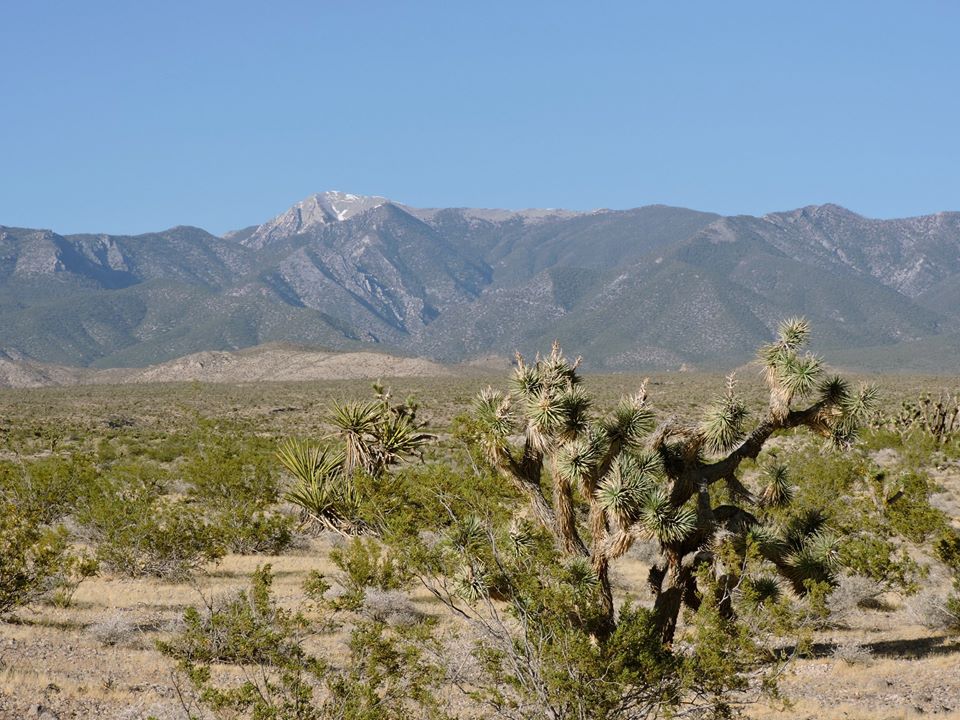
June 2, 2016 - Pahrump NV - Mt. Charleston seen from Carpenter Canyon, Spring Range, Nevada
This view will likely be quite different by this time next year. The Bureau of Land Management approved the Advanced Rail Energy Storage Project (ARES) in this location. It will extend far up onto this bajada. The proposed project is a 50 megawatt gravity based energy storage system that would be constructed on 72 acres (but will disturb over 150 acres for roads and transmission) of BLM managed public land.
We feel that the BLM undermined the visual impacts this development will have in their review. It will be visible from the summit of Mt. Charleston. BLM determined that over 4,000 Joshua trees and Mojave yuccas will be destroyed for the project. The project can only produce the full 50 MW capacity for about 20 minutes.
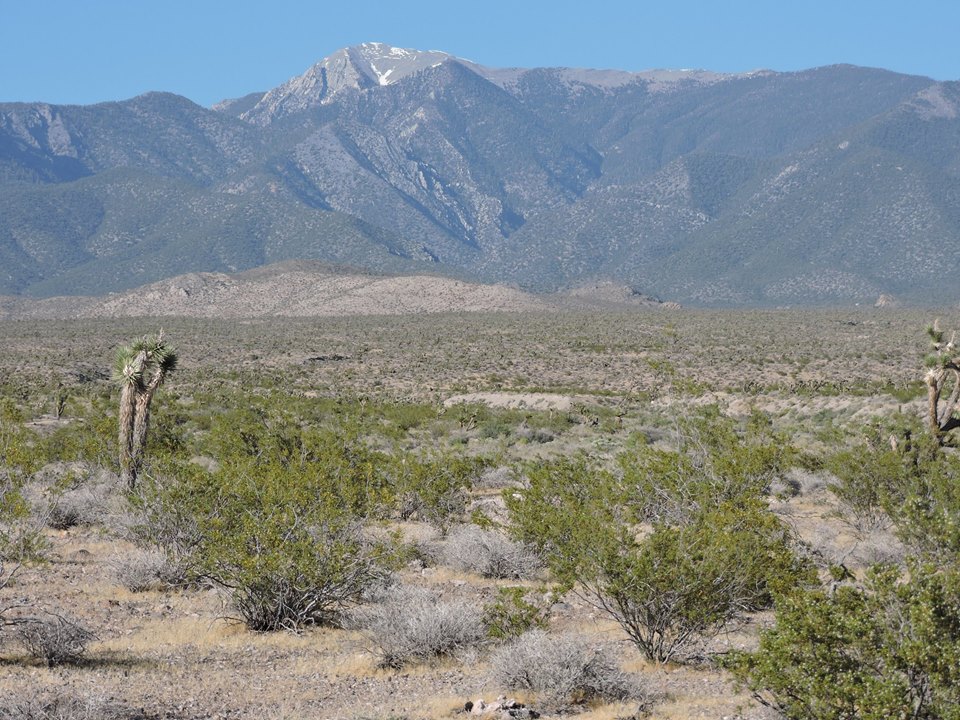
The rail track would extend up this alluvial fan just past the low light-colored hill at the top of the fan below Mt. Charleston.
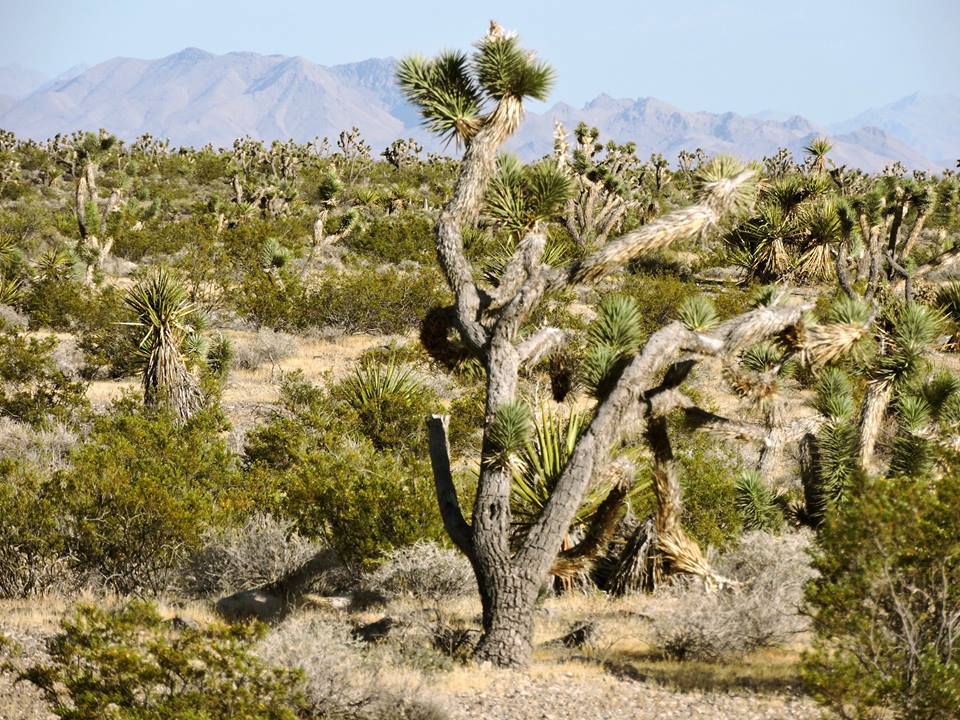
^This is the habitat which the rail storage project track will have to cut through, dense Joshua tree woodland on the alluvial fan of Carpenter Canton.
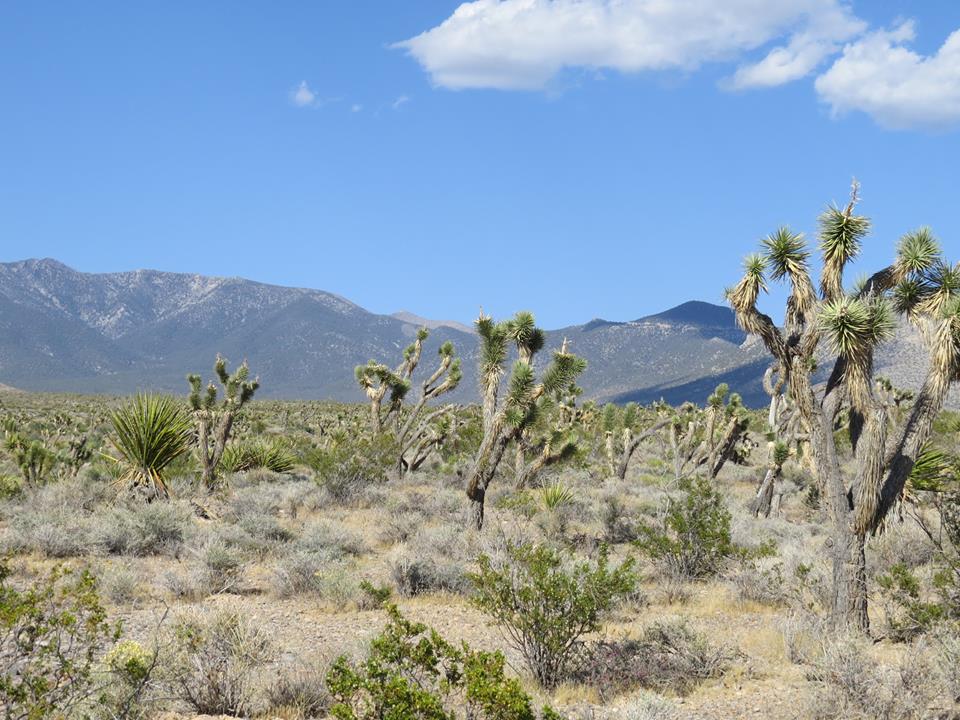
^Rail project will be developed on this upper fan.
Pahrump Rail Energy Storage Project
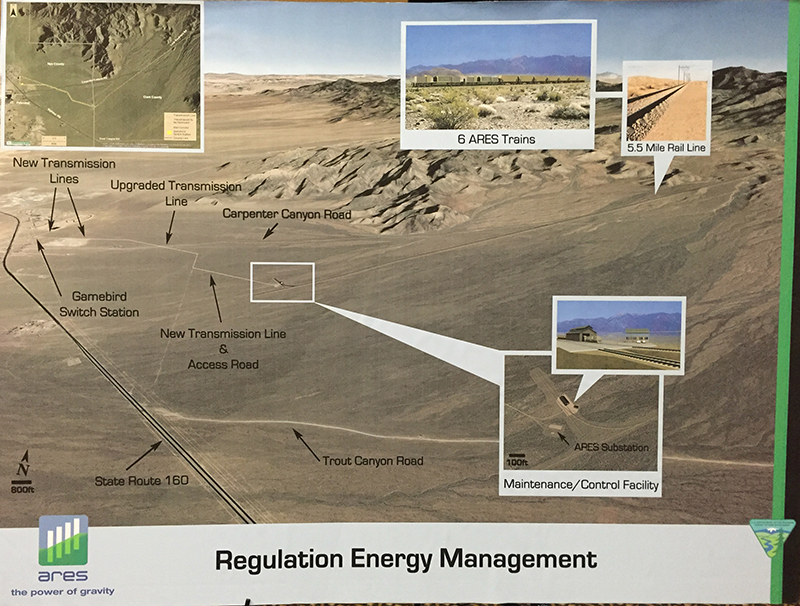
UPDATE - April 18, 2016 - The Bureau of Land Management approved the project and granted ARES a Right-of-Way to construct the rail storage project. We will be monitoring concept.
November 10, 2015 - Pahrump NV - At a meeting with the Bureau of Land Management (BLM), a new energy storage technology was discussed that will require public land on a large alluvial slope below Mt. Charleston near Carpenter Canyon in the Spring Range in Nye and Clark Counties. An Environmental Assessment is being prepared to review the project.
The applicant is Advanced Rail Energy Storage (ARES).
The Comment deadline is November 11, 2015. Send comments to Greg Helseth, 4701 North Torrey Pines Drive, Las Vegas, NV 89130. ghelseth@blm.gov
See http://www.blm.gov/nv/st/en/info/newsroom/2015/october/southern_nevada__0.html
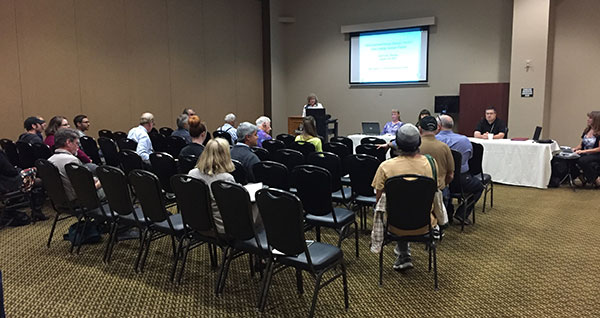
A single track, with 6 trains would use surplus solar or wind energy, or low cost energy from the grid to move rail cars up the slope. This is described as a 50 MW grid-scale ancillary services facility. The company says this technology could be scaled up to a gigawatt. Rail cars would be filled with motor generators, gravity works to generate electricity back on the grid.
The rail cars travel downhill at 5 - 19 mph, with the brakes generating electricity. This technology is being Patented, the first in the US. ARES says this technology can stabilize grid fluctuations of from intermittent solar and wind energy; this grid locally is now connected to the California Independent System Operator.
In total, 170 acres would be disturbed, 72 acres of which would be long-term infrastructure.
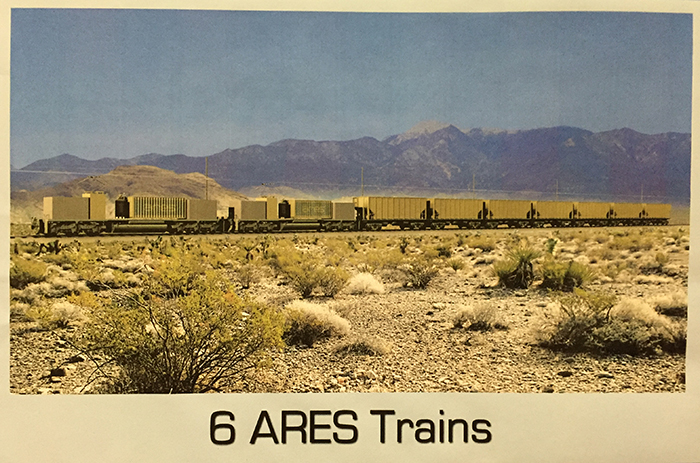
A small version of the rail storage system has been built at at Tehachapi, CA, a pilot project run for 6 months, but no operation was ended on that project. It had a third rail electric, the Pahrump version will have an overhead trolley-like transmission line. The company called it a "Shock absorber for grid."
There would be a track, maintenance facility, and a new hook up to the grid. Power poles along the track would be 90-100 feet tall. A new two mile transmission line and a one mile upgrade would be built to the Game Bird Substation, owned by Valley Electric Association (VEA). Interconnection would be to a VEA 230 kiloVolt line.
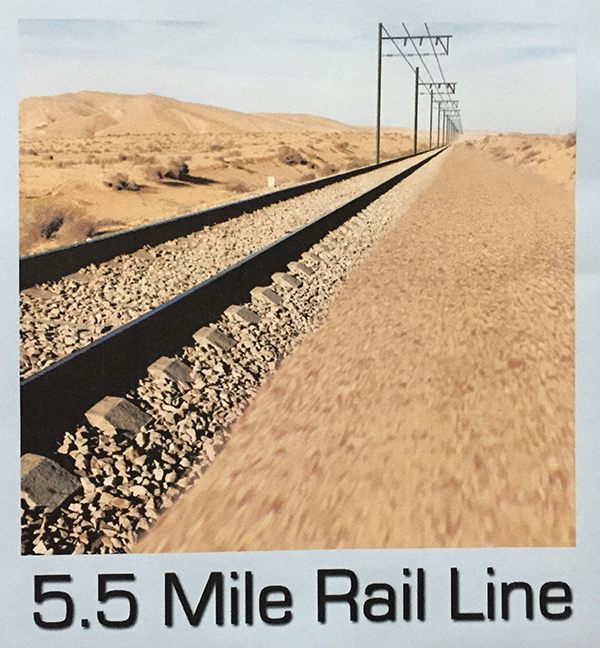
This would be an alternative to pumped hydro energy storage and batteries.
The project has all private financing, no government loans or grants.
There may be 15-18 employees in 3 shifts, 24 hours/day running, and a couple of administrative jobs. An Engineer would be in the train. Construction will take 9-12 months, with 100-125 construction jobs, plus monitors.
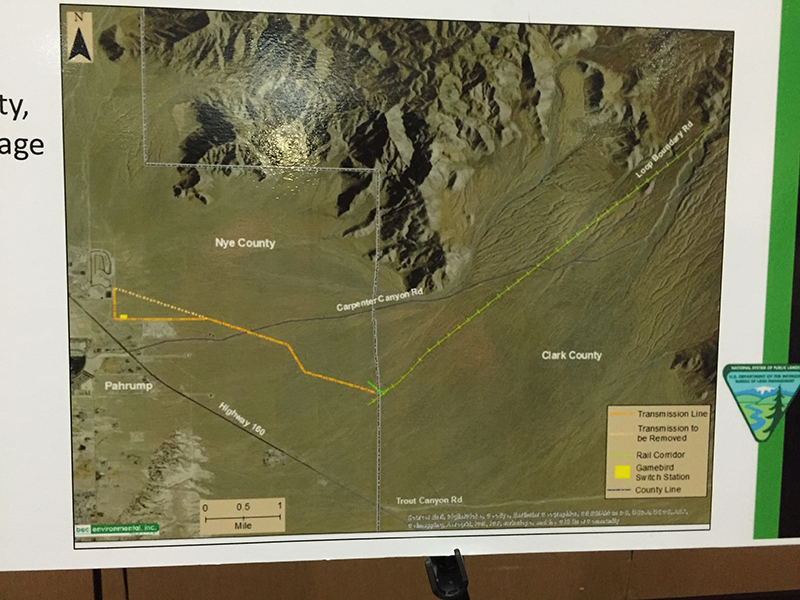
Tortoises in the Tracks
Tortoises could be trapped in the rails so the company will build escape ramps and exit tunnels along the track. Daily a biologist will walk the track to remove tortoises, any other animals, and bushes in way. The biologist may drive along road as well. This daily track check would occur for the project lifetime (around 40 years).
There will be no tortoise fences, but construction biological monitors will be present.
A lot of desert pavement will be disturbed. Impacted cactus and Joshua trees (near the top of the fan) will be removed and sold.
Flooding
The track will be built on an alluvial fan with a gentle slope, with the least cut and fill during construction. Drainage features will be kept to maintain existing flow. But we have concerns which we raised at the meeting about flooding and debris since an alluvial fan is built up by irregular rock and mud flows during storms. The BLM district manager told us they had dealt with this in the Environmental Assessment, but on page 84 of the EA, that say: " ARES would also prepare a Site Drainage Plan and Stormwater Pollution Prevention Plan (SWPPP)" So no hydrologic study was undertaken, and a plan to prevent flood damage to the structure or land surfaces and structures down slope is deferred until after public review and possible approval.

A map in the EA (p. 83) shows the lower part of the track in an active flood zone according to insurance sources. This year (2015) has been a active El Niño year, and the deserts in the region have already experienced large flood events that have closed roads. We ask that a flood control plan be prepared now, before the end of public review.
The Environmental Review states that Wheeler Wash was eliminated as an alternative due to flood control concerns: "Due to the topography of the area, extensive flood control measures would have been required to control and divert runoff from the Spring Mountains. Additional infrastructure and coordination with the Town of Pahrump and Nye County would have been required as well, due to the potentially modified runoff patterns which would drain into the Town of Pahrump. The negative economic impact on the Town and County could have been significant. This area is also adjacent to FEMA designated Zone AO: Areas subject to inundation by 1% annual chance shallow flooding (usually sheet flow on sloping terrain) where average depths are between one and three feet. Average flood depths derived from detailed hydraulic analyses are shown in this zone. Some Zone AOs have been designated in areas with high flood velocities such as alluvial fans and washes."
Carpenter Canyon wash may have the same flood control problems, and this needs to be analyzed.
Visual Impacts
The track will be equipped with downward facing security lighting. the rail cars will have gray paint to reduce visual impact.
Our comment about this is the region should have higher visual class as it is surrounded by scenic deserts vistas and next to the high peaks of Mt. Charleston.
Neighbors and Homes
We asked if this will it promote more energy sprawl in area?
During public comments, a retired man, wearing a Veteran's hat, said he will be the closest neighbor; "this thing will destroy my view as I sit on my porch," he said off Winery Road. He said there would be nothing to stop the noise, "it's wide open." He did not know about the project until now.
We asked if the agencies had evaluated noise on neighbors? BLM said they have studied noise dampening considerations, as well as cumulative impacts. The project will be bonded for land reclamation and cost recovery for compliance monitors.
Dust permits will be obtained for Carpenter Canyon Road, which is gravel and dirt, and palliatives will be used to keep dust down.
A commenter asked more tracks would added in the future? BLM said this would have to go through the environmental review process.
Efficiency
Is this project really efficient enough to work well to stabilize the grid?
The size of a power plant is usually represented by megawatts PER HOUR because the idea is to produce the maximum amount of electricity. Energy storage is usually represented by the TOTAL megawatts because the idea is the size of storage and the discharge rate can be intermittent or variable. 50 MW from a utility standpoint is not very much. The solar thermal trough power plant at
Kramer Junction CA has five 30 MW/hr facilities. 50 MWs total is 20 minutes of production, which is not enough to do much for utilities. A typical 1000 MW/hrs utility plant produces 1000 MWs every hour. Second the efficiency of electric motors will be less due to wear and tear, so that more than 50 MWs would need to be put in to receive 50 MWs.
This system is still a tradition steel-on-steel train, with inherent friction and drag. Mag lev trains are supported inches above a track by magnets to reduce friction. A much better idea would be to use large flywheels in a near vacuum supported by magnets.
Therefore we question how efficient this technology will be for such a large use of public lands, when distributed generation options could do more and have less environmental impacts.
Alternatives
We asked to include a battery storage alternative in the built environment, or slope for rail storage in the built environment.
Another alternative would simple accounting that utilities use all the time. For example, a solar plant or rooftop systems could be increased in size to have energy to store, and then the utility could cut back in the water flow over a hydroelectric dam during the day and increase it a night. It can all be done with a simple accounting function. Most utilities have hydro, so this will work at many of them, and solar power is already sold on a 24 hour basis using this accounting.
